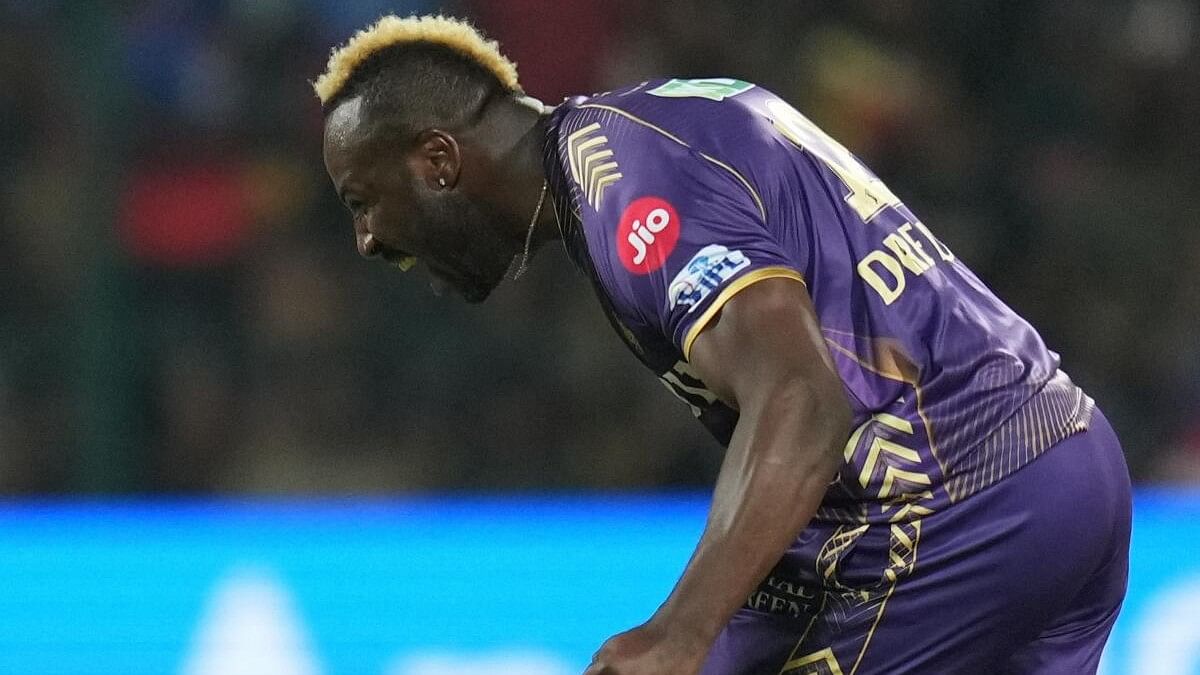
Kolkata Knight Riders' Andre Russell celebrates the wicket of Royal Challengers Bengaluru’s Cameron Green during the Indian Premier League (IPL) 2024 T20 cricket match between Royal Challengers Bengaluru and Kolkata Knight Riders, at M Chinnaswamy Stadium, in Bengaluru, Friday, March 29, 2024.
Credit: PTI Photo
Andre Russell had Virat Kohli, one of the finest batters of this generation, in a spot when Kolkata Knight Riders met the Royal Challengers Bangalore a couple of days ago.
Kohli was swatting flies at Russell’s myriad slower deliveries, but the one that made the former Indian skipper look particularly uncomfortable was the slower bouncer outside the off stump.
Actually, that delivery made everyone in RCB look bad save for Dinesh Karthik, who had to sit deep in the crease and throw the kitchen sink at the ball to shore up his side’s total.
The slower bouncer has become one of the most lethal deliveries in the shortest format because, when the line is on the fifth stump, it forces the batter to generate force while getting under it at the right time.
Given the lack of pace, the typical horizontal-bladed cut is not a shot that’s going to yield runs, the pull should be left for those of the brawny variety, the upper-cut will not so much as carry to the thirty-yard circle, and very few batters have the combination of timing and strength to play it over the bowler’s head.
The bouncer was always a problem, but now that the Indian Premier League allows two of them for the over, bowlers are having a lot of fun with it because, for the first time in a while, the bowlers were given something to help assist them in what was becoming a futile effort in trying to tie batters down.
"I think the bowlers get some help with this (the two bouncers rule),” Rajasthan Royals’ Sandeep Sharma had said earlier in the tournament. “Earlier, batsmen were able to predict where the bowler would bowl if he had used his one bouncer already. It would be easier for the batsmen. But with two bouncers, the batsmen are also in two minds that there's still one bouncer left for the bowler to use."
This change, admittedly, doesn’t do all that much because the margin for error when bowling a bouncer - given the size of most Indian grounds, and given the confidence with which most batters pull the ball- is small, but that’s for any delivery at this point.
Batters these days are unabashedly swinging through the line so much so that even the tacky nature of some of these Indian pitches have not stopped them from achieving success. The bowlers have thus had to fast-track the evolution into pace bowling which, historically, liked to be left alone in its quest of going from fast to faster.
Gujarat Titans Vijay Shankar shed more light on the new rule and its implications so far. “It has been a very tricky one – as a bowler, you can’t keep bowling that (bouncers), one has to use that in the right way. There are a few grounds in India which are really big in terms of square boundaries and in those venues, every fast-bowler will use bouncers,” said the all-rounder.
“Usually, after the first bouncer is bowled, as a batter, you typically become ready to hit the stripes. Now it is that anytime the bouncer can be bowled, or they can even use a slower bouncer. So, we need to be really smart as a batting unit and be prepared for the different kinds of deliveries one can face in a game.”
The Board of Control for Cricket in India had experimented with the rule during the Syed Mushtaq Ali Trophy earlier this year to a largely positive response, but given the nature of pitches, a lot of the bowlers still hold back on using the bouncer because when done wrong it sits up to be hit, even a mistimed pull can carry over the ’keeper’s head.
But the arrival of the slower bouncer has given the pacers more levy because unlike slipping up when bowling the yorker, especially under lights and when there is dew, this delivery is rarely going to upset the team’s plans should the field be set right.
Laxmipathy Balaji, the Tamil Nadu coach who oversaw this rule play out during SMAT, observed: “When you have two bouncers, you are bound to keep the batsman guessing. It is important how you use them. You have to spread it out - you can use one straightaway and another at the back end of the over. When you have that added luxury, you can construct an over to your plans and have more chances of making it work. The yorker, despite all the damage it can cause to a batsman, is difficult to execute. Wet ball, dew and the chances of it ending up as a full-toss will implant doubts. But with a bouncer, you will always have the confidence.”
In all, the ‘two bouncers an over’ rule has been a blessing for those who have worked on their craft in the off-season. For those who haven’t, it’s going be one rough night after another.